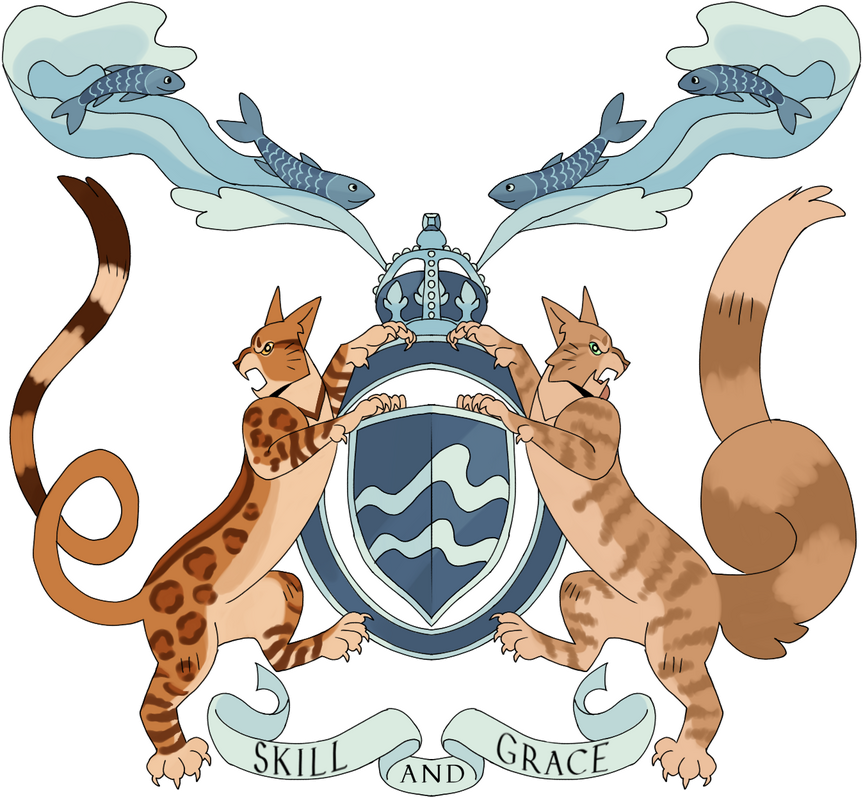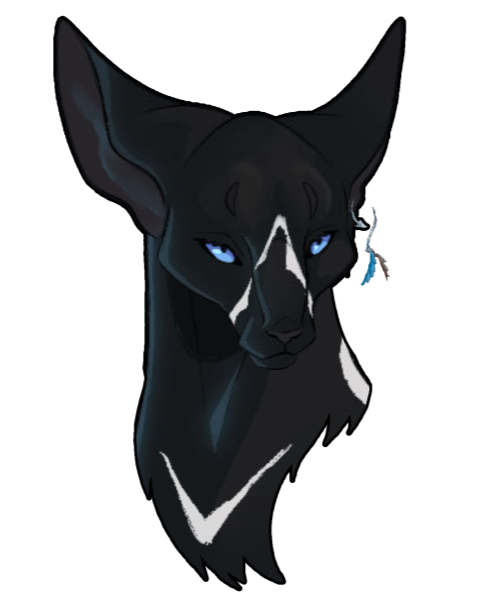Riverclan

Riverclan, residing along the riverbank near the lake, thrives in a lush, water-rich environment. Known for their swimming prowess and fish-catching skills, their territory is characterized by its wide, flowing rivers and fertile wetlands. Riverclan cats possess sleek, water-resistant coats and strong limbs, ideal for navigating their aquatic habitat.Their camp is strategically positioned on an island or high ground near the river, protected by natural barriers such as water and dense reeds. This location provides both safety from potential threats and proximity to their primary food source: fish. The clan's warriors are skilled in both swimming and fishing, allowing them to make the most of their watery environment. While their territory's abundance of water offers advantages, it also demands vigilance, as swift currents and occasional flooding pose challenges.
Highranks
Leader
Bettastar
Undaunted under the tutelage of his ancient ancestors, Bettastar commands the operations of Riverclan with icy blue optics. And similar to his namesake, this leader is reserved and confrontational in the presence of strangers or enemies, as well as competitive in nature. This mysterious tom has a side of vibrancy that blossoms when it comes to new life, the alliances he has formed, and the prosperity and survival of Riverclan, showing that his body is not solely made up of negative energy. But even then, Bettastar lacks a filter, and will never hesitate to lunge at the throat of another for any misbehavior he finds daunting, especially during sacred times. He is a leader, not a father. And is a legendary force in the forest that should be respected.
Deputy
Coming soon!
Medicine Cat

Cormorantcroon
Cormorantcroon is a regal and composed figure with a sharp mind. Although he is generally polite and articulate, his austere nature can be off-putting. His insistence on efficiency and practicality can come across as dismissive and harsh. He is not warm or friendly in the conventional sense, but his good nature shows in other ways: his cunning is never cruel, and he makes a point to never raise his voice, even in anger. Behind his aloof attitude, he is affectionate and has a dry, subtle sense of humour. Beside the drifting willow fronds, he rises over the reeds withstriking oriental features: an angular face, aquiline nose, upturned eyes and large ears. A stunning authority, if ever there was one.
Medcat Apprentice
Coming soon!
Allegiances
Warriors
WHEATWHISKER — very fluffy tomcat that is cream and dark brown colored that has sage green eyes with a bow and bandana.FORESTBONE — medium furred silver colored rosette tabby trans male with pale blue eyes.PIKETAIL — slender mossy-grey tom with dark brown stripes, white socks, turtle bite scar on his left paw and dark gold eyes.CINDERPELT — sleek calico she-cat with sharp earthy green eyes and a voice low and smooth as riverstones.KOISPLASH — calico tom, having bright blue eyes and a careless stare.
Apprentices
SHELLPAW — gray cat with white splotches with and yellow eyes.
Queens
MOURNINGCOO — stout brown silk-furred tom with a round plump appearance, sandy mane and tail, and sandy-colored eyes.
Kits
COALKIT — small fluffy-furred ashen-grey with a plump appearance, folded right ear, and large frosty-blue eyes.
Elders
SLEEKFIN — thick plush white and grey toned she-cat with blue eyes.

Lifestyle
Riverclan resides along the riverbank, central to their way of life. Their territory also includes lush meadows, marshlands, and, of course, the winding river that serves as both a resource and a boundary. The constant presence of water shapes their lifestyle as a clan.
Hunting and Fishing
Riverclan cats are renowned for their fishing skills. Unlike other clans that rely heavily on land prey, Riverclan specializes in catching fish from the river. They have developed techniques to catch various types of fish, such as trout and salmon. Their keen eyesight and swift reflexes aid them in this essential task.Riverclan cats use their paws and sharp claws to snatch fish from the water. They are adept at timing their strikes to coincide with the fish’s movements. But while fish are their primary food source, they also hunt small mammals and birds found along the riverbanks. Warriors and apprentices that exclusively hunt on land are called Drypaws and are often teased.
Weaving Nests
In Riverclan, weaving nests is a common and practical activity due to their proximity to water and the need for comfortable, waterproof bedding. The primary material used for weaving nests are reeds. These are collected from the riverbanks and are valued for their flexibility and durability. Rushes are similar to reeds but often used to provide a softer, more cushioned layer. Additional materials like moss and grass can be used to line the nests for extra comfort and insulation. Waterfoul feathers are prized, and especially valuable in lining the roof of dens, to ensure rain doesn't seep through.
Collection and Preparation
Cats gather reeds, rushes, and other natural materials from the riverbank. The materials are cleaned and sorted. Reeds are often soaked to make them more pliable. Feathers are cleaned thoroughly with watermint to prevent lice.
Weaving and Lining
Cats weave the reeds and rushes into a sturdy base. The weaving technique involves interlocking the materials in a crisscross pattern to create a stable and comfortable structure. Once the basic structure is complete, nests are lined with softer grass and moss for added comfort. They may also be decorated with shells, and flowers.
Seasonal Activities
Riverclan’s activities often revolve around the changing seasons and river conditions. In newleaf, they may hold friendly contests to see who can catch the most fish. And they may also have flood preparations, ensuring that their nests and territories are secure from seasonal flooding. The river can rise during heavy rains, affecting the clan’s territory. RiverClan cats are adept at moving their nests and adapting their hunting techniques to cope with these changes.
Resources
Watermint (Mentha aquatica)
Watermint is a robust plant with green, lance-shaped leaves and small, purple flowers arranged in dense clusters. The plant has a strong, minty aroma and can grow up to 2 feet tall. Watermint is used to aid digestion, relieve nausea, and treat coughs and colds. It has cooling and soothing properties that are beneficial for gastrointestinal issues.Where to Find: Watermint thrives in moist, often marshy areas, including riverbanks and the edges of ponds. It prefers wet, nutrient-rich soil and partial to full sunlight.
Bugleweed (Ajuga reptans)
Bugleweed is a low-growing herb with broad, oval leaves and spikes of blue or violet flowers. The plant has a somewhat medicinal aroma and can spread across the ground in dense mats. Bugleweed is used to treat anxiety, coughs, and minor wounds. It has calming and anti-inflammatory properties.Where to Find: Bugleweed is commonly found in wet woodlands, along riverbanks, and in shaded, damp areas. It thrives in moist, well-drained soil and can often be seen spreading across the forest floor.
Horsetail (Equisetum arvense)
Horsetail is a distinctive plant with jointed, leafless stems that resemble a horse’s tail. The plant can grow up to 3 feet tall and has a rough texture. Horsetail is used to strengthen bones, treat urinary tract infections, and aid in wound healing. It has diuretic and astringent properties.Where to Find: Horsetail grows in wet, sandy, or loamy soil, particularly in riverbanks, floodplains, and marshy areas. It prefers moist environments and often thrives in areas with high humidity.
Jenny (Lysimachia nummularia)
Creeping Jenny is a low-growing herb with rounded, kidney-shaped leaves that turn golden yellow in autumn. It produces small, cup-shaped yellow flowers. The plant is used for its diuretic properties and to treat skin conditions and minor wounds. It has mild astringent and anti-inflammatory effects.Where to Find: Creeping Jenny is found in moist, shaded areas, often near riverbanks and flood-prone regions. It prefers damp, well-drained soil and can often be seen spreading across the ground.
Reed Grass (Calamagrostis spp.)
Reed Grass is a tall, slender grass with feathery seed heads that turn a golden brown as they mature. The plant can grow up to 5 feet tall and has a distinct grassy aroma. Reed Grass is used for its soothing properties in treating urinary tract issues and minor wounds. It has anti-inflammatory and astringent qualities.Where to Find: Reed Grass grows in wet, marshy areas, along riverbanks, and in floodplains. It thrives in saturated soil and is often found in dense stands near water sources.
Wild Celery (Apium graveolens)
Wild Celery is a tall herb with feathery leaves and small, white flowers clustered in umbels. The plant has a strong, celery-like scent and can grow up to 3 feet tall. Wild Celery is used to aid digestion, relieve bloating, and treat minor digestive issues. It has diuretic and carminative properties.Where to Find: Wild Celery is commonly found in wet meadows, riverbanks, and floodplains. It prefers moist, fertile soil and is often seen growing in lush, dense patches.